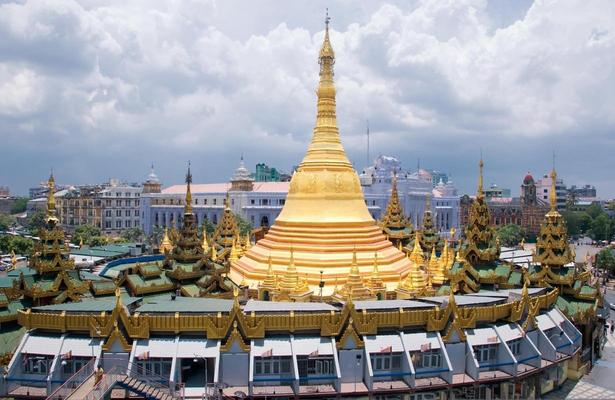Yangon, a colonial open-air museum
Yangón is not pretty, but she is very nice and is learning to show off her decadence. The former Burmese capital is one of the oldest cities in Southeast Asia, whose eventful history has left its mark on the buildings and pavement. But recently, a bit of shade here and a bit of blush there are making this city begin to court suitors to invite her for a walk.
It is nine o'clock in the morning in Mahabandoola Park, a symbol of the country's sovereignty and still the heart of Yangon, although it is no longer its geographical center, as it was during the British colonial era, to which the city owes its current layout. of its historic center. Upon arrival, Gino greets alluding to the heat that he is already at this hour. This is what the end of the monsoon has: the rains go away but a torrid sun shines again.
Gino is in love with Yangon, a relationship that has already lasted eight years. Tired of teaching English, this Australian has begun to fill a void that existed here in the form of guided sightseeing tours. “Like any city worth its salt, Yangon also needs guided tours on foot, which is the best way to get to know it. Although walking through these streets requires some care because of all the holes it has. It seems like an easy joke, rehearsed and improved with practice, but Yangonite asphalt has many holes and few sidewalks, which are also usually occupied by stalls and street restaurants alternated with precipices that show their entrails.
The four hairs of Buddha
In the park, in front of the majestic city hall building, Gino explains that it is considered an exercise in syncretizing Burmese colonial architecture, in which oriental elements stand out, such as the traditional roof in the form of tiered spiers called pyatthat (common in pagodas , Buddhist monasteries and palaces), or the sculptures of two dragons on the cover. In another era the building was a different color, but since 2012 it has presented a remarkable and delicate celestial blue that contrasts with the green of the palm trees that surround it and the gold of the Sulé pagoda, located opposite, another of the symbols of the city. In it, for approximately 2,500 years, one of the four hairs of Buddha that are preserved in the city has been kept.

Immediately we leave behind us the obelisk located in the center of the park, currently called the Monument to Independence, although during the Second World War the Japanese flag flew in its place and previously a statue of Queen Victoria of England occupied the position, to leave and transport us to colonial times with the Court of Justice, still a majestic building dating from 1911 and whose British influence is impossible to deny, especially because of the clock tower, a distant reflection of London's iconic Big Ben.
More than a hundred colonial buildings still remain in Yangon, many in ruins and closed to the public, a forgotten heritage from the times when Yangon was one of the most important ports of the British Empire, of which it was a colony since 1852, first as one more province of the British Raj in India and already in 1937 with its own legislation, justice and administration.
Guide by vocation
There are, apart from the colonial ones, other interesting buildings in Yangon, such as the Musmeah Yeshua synagogue, the headquarters of the Burma Railway Company, now in the process of being converted into a five-star hotel, the popular Secretariat, where Aung San was assassinated , father of the country's independence, or the Yangon General Hospital. By location they are included in another different tour also designed by this Australian guide, in exchange for the will.
But Gino isn't the only one running free tours in English; Currently, the Yangon Heritage Trustee Foundation, which has been working with the government for several years to preserve these heritage jewels, also offers this type of tour, although the guides tend to insist more on the activity carried out by the foundation than on the legacy itself. colonial.
The Court of Justice building continues to be used, although since the founding of the new capital, Nay Pyi Taw, in 2008, its jurisdiction has been reduced to the regional level and part of it is disabled. Gino recalls that few colonial buildings in Yangon are in use; only some, like houses. Most of these buildings are abandoned and, although entry to many of them is prohibited, for a couple of dollars you can get to take a look inside.
pego's club
This is the case of Pego's club, exclusive for British and a few prestigious Burmese and Indian citizens. Saving the cobwebs, you can still admire the dance halls, the game tables, the billiard rooms and even feel the smell of tobacco consumed in the timbas that were held every night in this architectural relic of the then colonial city of Yangon.
Surrounding the park in a clockwise direction, we find, next to the Court of Justice, two renovated period buildings. Now headquarters of new banks, one of them housed an old Anglican church of which some details can still be seen. Then, the Immigration Office, the Inland River Transport Company, the Port Authority, the Strand Hotel, the Customs building, some old warehouses, archaic printing houses, and even street name signs in colonial times, complete the visit.
After three hours I conclude that, indeed, walking around Yangon is not the most comfortable and pleasant, but I begin to look at the city in a different way. I already knew her sympathy, but now I also see her prettier.
Find inspiration for your next trips on our Facebook and Twitter and Instagram or subscribe to the El Viajero Newsletter here.









1612